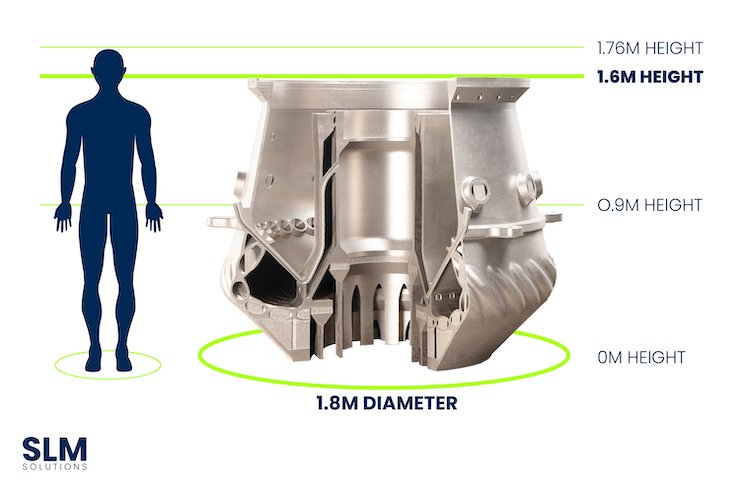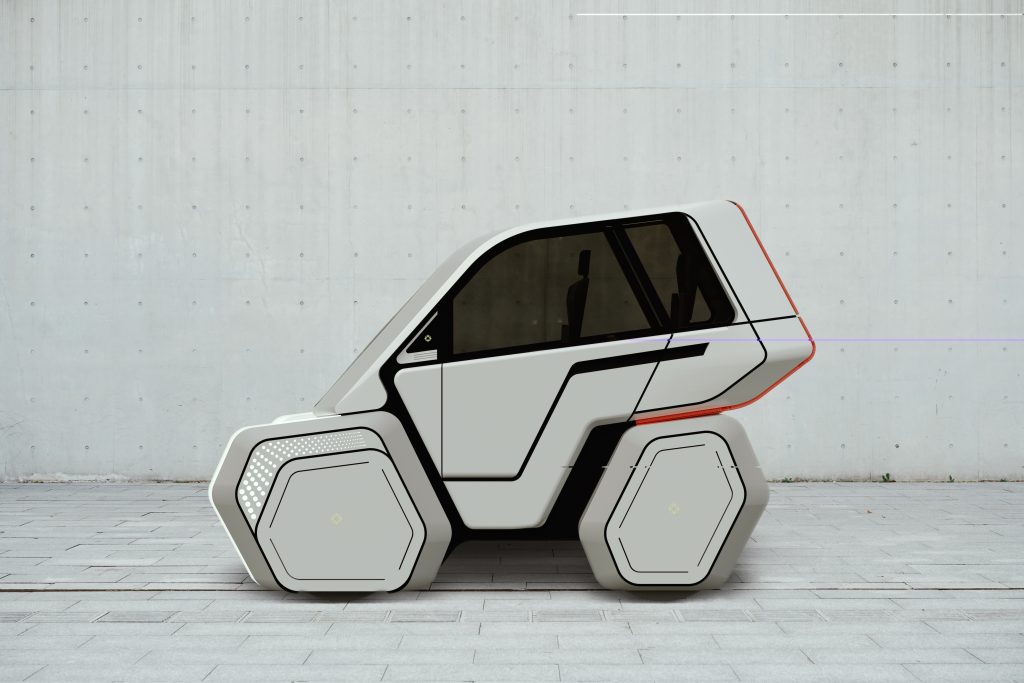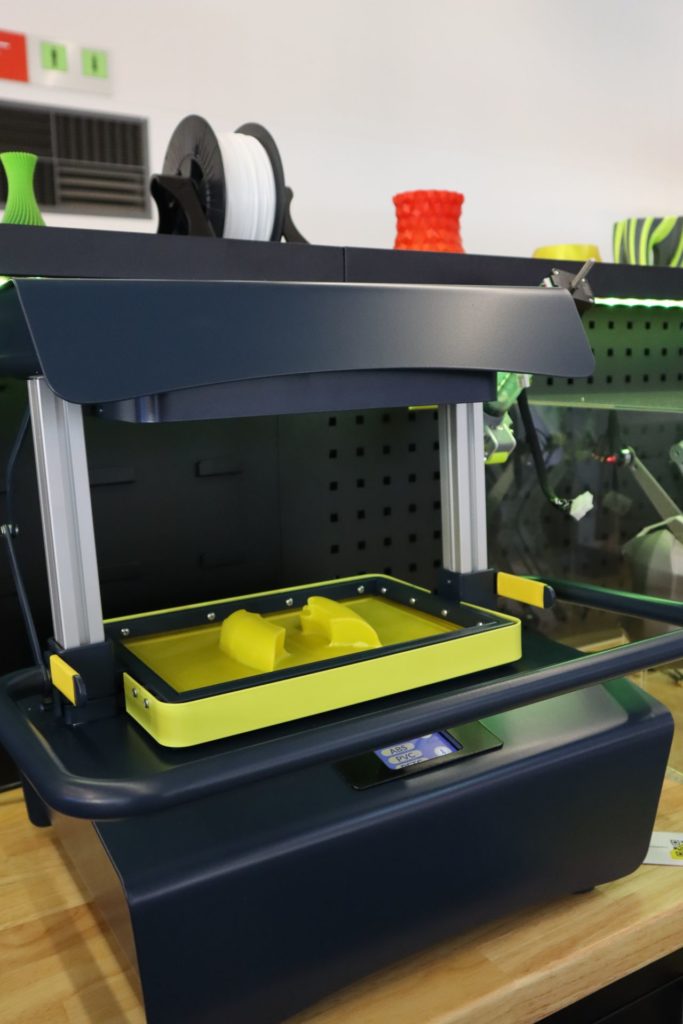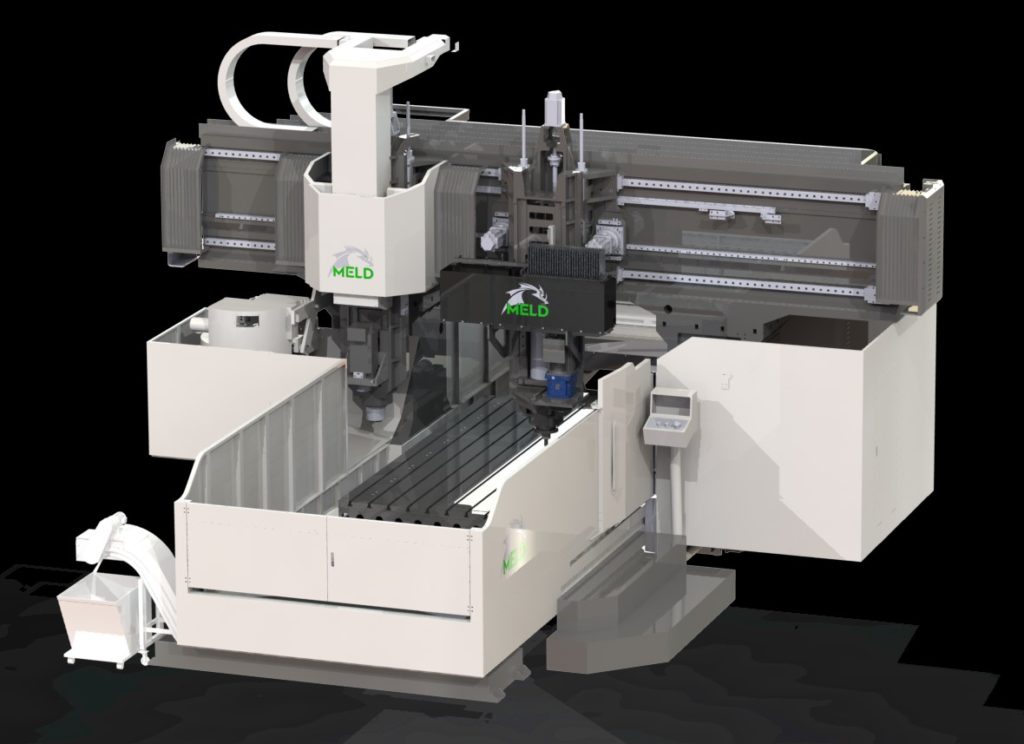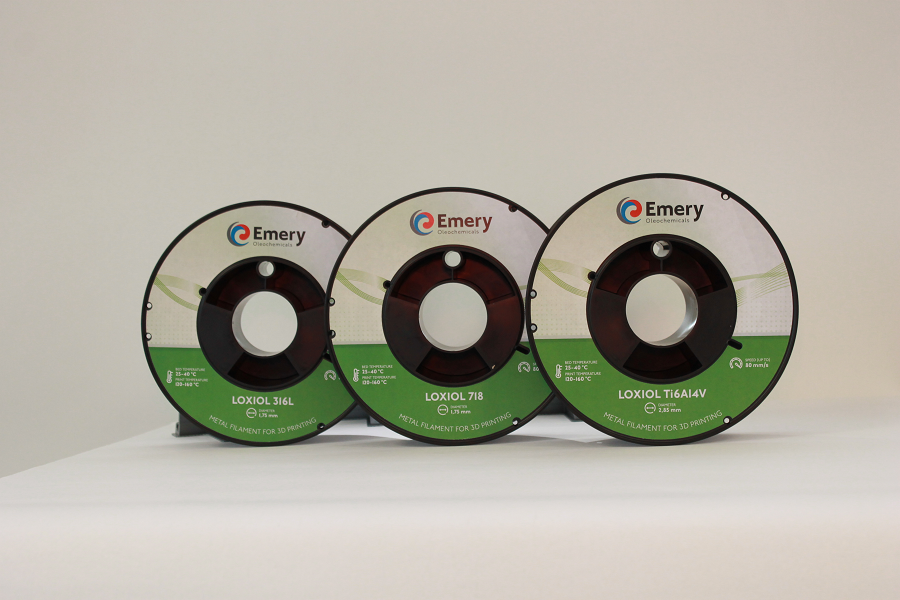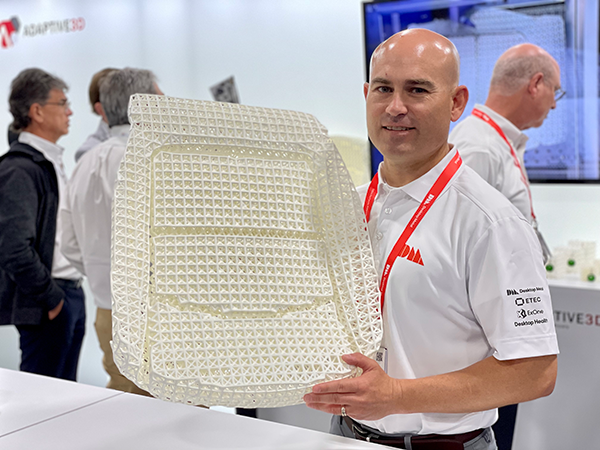While additive construction is being deployed at this very moment to aid in a military conflict between India and China, the additive manufacturing (AM) industry is focused on Germany. We’ll see how the numbers stack up after the event, but there’s a sense that Formnext 2022 is the largest trade show the AM industry has seen so far. To tackle all of the news out of the conference taking place in Frankfurt, Germany right now, we’ve publishing several roundups dedicated to 3D printing hardware, software, materials and more. In this post, we’ll provide a brief overview of the materials news that we haven’t gotten a chance to dedicate entire articles to.
SLM Solutions Teases Biggest LPBF 3D Printer
After announcing the introduction of its NXG XII 600E LPBF 3D printer with a build envelope of 600 x 600 x 1500 mm, SLM Solutions (AM3D.DE) teased an even larger system with a build volume of 3.0 x 1.2 x 1.2 meters. Because the printer wasn’t actually shown at Formnext (not that such a large machine could necessarily be brought to the site), the news seems intended to one-up Chinese LPBF manufacturer EPlus3D, which announced a 3D printer bigger than the NXG XII 600E just ahead of the trade show.
3D Printed EV from Stratasys and nFrontier
At this year’s event, 3D printer manufacturer Stratasys (Nasdaq: SSYS) unveiled UILA, a 3D printed mobility solution prototype designed by German firm nFrontier. Combining an electric bike with an electric vehicle, the UILA is a four-wheeled two-seater with a range of 60-70 km, a top speed of 25 km/hr and a weight of just 70 kg. UILA is prepping for serial production and traffic registration in Germany in 2024. Fused deposition modeling (FDM) was used to 3D print the large body components, while it is designed to use Stratasys’ selective absorption fusion (SAF) and P3 technology for production.
ZMORPH SHAPE Thermoforming Machine
After being rescued by and integrated into Sygnis, Polish desktop 3D printer manufacturer Zmorph has released a new machine, ZMORPH SHAPE, which is a table-top vacuum thermoforming machine. The system is designed to be used safely without additional protective measures or external devices.
MELD’s New Large-Scale Metal 3D Printer
With everyone at Formnext posing next to a model of R2D2, MELD Manufacturing Corporation unveiled its latest Star Wars-inspired 3D printing robot, 3PO. The massive machine measures 4 m x 2.7 m x 1 m and features integrated subtractive capabilities in the form of a standard three-axis or optional five-axis milling head. With MELD’s friction welding-style 3D printing process, the system can print with aluminum, titanium, steel and nickel-based superalloys.
Emery Oleochemicals’s Metal 3D Printing Filament Line
A joint venture between two Malaysian companies (PTT Global Chemical of Thailand and Sime Darby Plantation of Malaysia) and one of the largest oleochemical manufacturers in the United States, Emery Oleochemicals, introduced a broad range of metal 3D printing filaments as a part of its LOXIOL product line. With five materials available in 1.75mm and 2.85mm, the portfolio includes 316L, 17-4PH, 718, Copper, and Ti6Al4V. From this author’s knowledge, Emery is one of only three manufacturers of metal filaments, aside from German giant BASF and The Virtual Foundry. Otherwise, the options for metal extrusion are Desktop Metal, Markforged, and 3DGence, who is a partner of Emery.
Desktop Metal FreeFoam and the VA
Desktop Metal (NYSE: DM) was awarded a three-year, multimillion-dollar contract with the Veterans Health Administration (VA) to create 3D printed healthcare products made with its unique FreeFoam material. Under the $2 million contract, the VA will receive an Xtreme 8K digital light processing (DLP) 3D printer and other equipment. After successful milestones are completed, the project has the potential to grow to $7 million.
AddUp’s FormUp 350 Evolution Metal 3D Printer
A joint venture between Michelin and Fives, AddUp has introduced its latest laser powder bed fusion (LPBF) 3D printer, the FormUp 350 Evolution. The system is an upgrade to the preceding four-laser FormUp 350, featuring an increased build height of 1000mm, growing the total build volume by 185 percent. The build chamber is extractible, enabling rapid changeover and depowdering outside of the machine. Because it is based on the previous machine, printing parameters that were developed on the existing system can be applied to the new one, set to be released in 2023.
Morf3D Partners with Equispheres
Canadian metal maker Equispheres has found an important partner in Nikon subsidiary Morf3D. Due to the consistency and sphericity of the company’s aluminum powders, Equispheres has demonstrated a potential increase in LPBF throughput speed of up to 30 percent. Morf3D will qualify and develop new applications for Equispheres’ materials.
Nano Dimension and Tethon 3D Team for Micro 3D Printing
Together with materials developer Tethon 3D, Nano Dimension will be developing materials for its Fabrica 2.0 micro 3D printing system. The focus is on high-performance and specialty specifications, such as high temperature, transparent, and carbon nano tubes. Applications include electrical connectors, medical devices and microfluidic chips.
pro-beam Presents EBM Metal 3D Printer
One of the few players in the electron beam PBF space, the pro-beam Group, presented new details about its PB EBM 30S 3D printer. Designed for serial manufacturing, the system performs production steps for setup, evacuation, 3D printing, and cooling in parallel via modular BuildUnits. The BuildUnits—available in 160 x 160 x 400 mm and 300 x 300 x 400 mm sizes—in pass through the printer where these operations are performed. While the smaller units are better suited for material qualification, the larger is designed for production, making it possible to optimize powder usage for the application. The use of RainTec spot strategy relies on heat input controlled for specific requirements, with individual spots melted stochastically to prevent warping and improve surface quality
6K’s Low Oxygen Ti-64
Powder maker 6K Additive announced the availability of ultra-low oxygen titanium 64 with parts per million range of 500 – 700. This lowers the overall cost for titanium parts with powder that stays with-in printable specification longer.
“The global supply chain crisis has caused volatility in the market for metals like titanium which leads to uncertainty in costs and availability. Our ability to provide low-oxygen titanium at production volumes enables our customer to stretch their powder use well beyond what’s available today, essentially increasing value and lowering costs for their Ti64 parts,” said Frank Roberts, president of 6K Additive.
Mark Barfoot, director of AM programs at EWI, commented, “When we talk to Ti64 users in the market, quality always is top priority with costs following a close second. Increasing the value of their Ti64 purchase by extending the life of the powder with more uses is a definite win.”
Subscribe to Our Email Newsletter
Stay up-to-date on all the latest news from the 3D printing industry and receive information and offers from third party vendors.
You May Also Like
Further Understanding of 3D Printing Design at ADDITIV Design World
ADDITIV is back once again! This time, the virtual platform for additive manufacturing will be holding the first-ever edition of ADDITIV Design World on May 23rd from 9:00 AM –...
3D Printer Maker EVO-tech Reborn as NEVO3D — Once More With Feeling
EVO-tech was a 3D printing service and original equipment manufacturer established in 2013 and based in Schörfling am Attersee, Austria. The company produced high-quality material extrusion systems featuring linear bearings,...
3D Systems Brings 3D Printed PEEK Cranial Implant to the U.S. with FDA Clearance
For more than 10 years, 3D Systems (NYSE:DDD) has worked hand-in-hand with surgeons to plan over 150,000 patient-specific cases, and develop more than two million instruments and implants from its...
CDFAM Returns to Berlin for Second Annual Symposium
The second CDFAM Computational Design Symposium is scheduled for May 7-8, 2024, in Berlin, and will convene leading experts in computational design across all scales. Building upon the first event...


